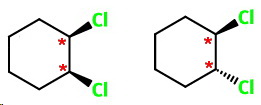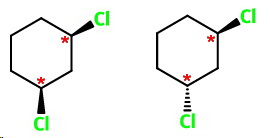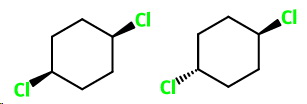Question #b0259
1 Answer
There are eight stereoisomers of dichlorocyclohexane.
Explanation:
You can have 1,2-, 1,3-, and 1,4-dichlorocyclohexane, and each of these can exist as the cis and trans isomers.
Since cyclohexane rapidly converts from one chair form to the other, we can consider it as if it were a flat ring.
Let's draw each of these isomers. The chiral carbons are marked with an asterisk.
cis- and trans-1,2-Dichlorocyclohexane

The cis isomer is a meso compound, but the trans isomer exists as a pair of enantiomers.
cis- and trans-1,3-Dichlorocyclohexane

The cis isomer is a meso compound, but the trans isomer exists as a pair of enantiomers.
cis- and trans-1,4-Dichlorocyclohexane

There are no chiral carbons in these isomers.
Thus, there are three 1,2-stereoisomers, three 1,3-stereoisomers, and two 1,4 stereoisomers.

